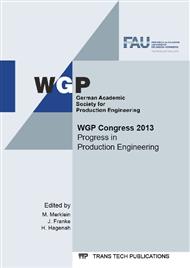[1]
D. Dornfeld, S. Min, Y. Takeuchi, Recent Advances in Mechanical Micromachining, CIRP Annals - Manufacturing Technology 55 (2006) 2 745-768.
DOI: 10.1016/j.cirp.2006.10.006
Google Scholar
[2]
R. Narayan, R. M.Pilliar, Biomedical Materials, SpringerLink. (2009) 41-81.
Google Scholar
[3]
J. J. Ramsdena, D.M. Allena, D.J. Stephensona, J.R. Alcocka, G.N. Peggsb, G. Fullera, G. Gochc, The Design and Manufacture of Biomedical Surfaces, CIRP Annals - Manufacturing Technology 56 (2007) 1 687-711.www.fivesgroup.com
Google Scholar
[4]
T. Thepsonthi, T. Özel, Multi-Objective Process Optimization for Micro-end Milling of Ti-6Al-4V Titanium Alloy, International Journal of Advanced Manufacturing Technology. 63 (2012) 9 903-914.
DOI: 10.1007/s00170-012-3980-z
Google Scholar
[5]
S, Fischer, Fertigungssysteme zur spanenden Herstellung von Mikrostrukturen, Disseratation, Aachen, 2000.
Google Scholar
[6]
J. C. Aurich, R. Haberland, G. M. Schueler, J. Engmann, 2008, A New Approach for Using Micro-End Mills at High Rotational Speed and Ultra Low Run-Out, Proceedings of the 3rd International Conference on High Performance Cutting, Dublin, Ireland, 189–197.
Google Scholar
[7]
D. Kong, S. Choi, Y. Yasui, S. Pavanaskar, D. Dornfeld, P. Wright, Software-based tool path evaluation for environmental sustainability, Journal of Manufacturing Systems. 30 (2011) 4 241–247.
DOI: 10.1016/j.jmsy.2011.08.005
Google Scholar
[8]
S. Dimov, D. T. Pham, A. Ivanov, K. Popov, K. Fansen, Micromilling strategies: optimization issues. Proceedings of the Institution of Mechanical Engineers, Part B (Journal of Engineering Manufacture). 218 (2004) 7 731-736.
DOI: 10.1177/095440540421800706
Google Scholar
[9]
S. H. Ryu, D. K. Choi, C. N. Chu, Roughness and texture generation on end milled surfaces, International Journal of Machine Tools & Manufacture. 46 (2006) 404–412.
DOI: 10.1016/j.ijmachtools.2005.05.010
Google Scholar
[10]
P. Franco, M. Estrems, F. Faura, A study of back cutting surface finish from tool errors and machine tool deviations during face milling, International Journal of Machine Tools and Manufacture. 48 (2008) 1 112-123.
DOI: 10.1016/j.ijmachtools.2007.07.001
Google Scholar
[11]
C. K. Toh, Surface topography analysis in high speed finish milling inclined hardened steel, Precision Engineering. 28 (2004) 386–398.
DOI: 10.1016/j.precisioneng.2004.01.001
Google Scholar
[12]
K. Anselme, L. Ploux, A. Ponche, Cell/Material Interfaces: Influence of Surface Chemistry and Surface Topography on Cell Adhesion, Journal of Adhesion Science and Technology. 24 (2010) 831-852.
DOI: 10.1163/016942409x12598231568186
Google Scholar
[13]
J. C. Aurich, I. G. Reichenbach, G. M. Schüler, Manufacture and application of ultra-small micro end mills, CIRP Annals - Manufacturing Technology. 61 (2012) 1 83-86.www.fivesgroup.com
DOI: 10.1016/j.cirp.2012.03.012
Google Scholar
[14]
G. M. Schueler, J. Engmann, T. Marx, R. Haberland, J. C. Aurich, Burr formation and surface characteristics in micro-end milling of titanium alloys. Proceedings of the International Conference on Burrs – Analysis, Control and Removal, Springer. (2010) 129–138.
DOI: 10.1007/978-3-642-00568-8_14
Google Scholar
[15]
B. H. Kim, C. N. Chu, Texture prediction of milled surfaces using texture superposition method, Computer-Aided Design. 31 (1999) 485-494.
DOI: 10.1016/s0010-4485(99)00045-7
Google Scholar


